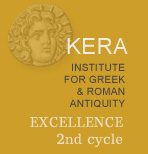Main Site . Other insciptions from the main site of Boubon
31. Honorary inscription for Troilos alias Klearchos
![]()
5 10 |
[Β]ο[υβωνέ]ω̣ν̣ [ἡ β]ουλὴ κ̣αὶ ὁ δῆ– |
The council and the people of Boubon, having honored [---] also with a crown Troilos alias Klearchos [---]los, son of Klearchos, son of Troilos, son of Molesis, citizen of Boubon, (a man) of important ancestors without exception, a relative of front-ranking (citizens) who exercised all public offices with [---] and in accordance to [the nobility of?] his [descent?], who fulfilled the office of priest of the emperors [generously?] and provided a feast for all,...
Rectangular base, found and documented by Heberday in Boubon (no further specification) in 1895. It was already broken in many pieces when Bean and Schindler saw the stone. Its surface was to some extent corroded ("ziemlich korrodiert").
Height: ca. 110 cm; length: ca. 42 cm; depth: ca. 44 cm; letters: 2 cm.
Schindler 1972, no. 8 (pl. 3.13: Heberdey's squeeze); Milner 1998, p. 2, no. 1.21; BullÉp 1973, no. 455.
L. 2 : In the lacuna before [τειμή]σας probably πάλιν.
L. 3 : Τρωΐλος: see no. 23.
L. 9 : Either φιλοτείμως (φιλοτίμως) or μεγαλοφρόνως. In both cases the meaning would be generously; cf. Robert 1940, p. 44; for ἀναλόγως with genitive instead of dative cf. FD III, no. 118 and Robert 1938, pp. 19-20.
L. 10 : Most likely εὐ[σχημοσύνη]ς or εὐ[γενεία]ς. Schindler understood αὐτοῦ as the subject of a genitive absolute refering to the honorand himself, after the exploits and merits of his ancestors have been presented in the previous section. But the genitive plural –α̣σάντων, two lines further down in the text, speaks against this assumption. It seems, rather, that the entire surviving part of this inscription was dedicated to the honorand's ancestors. Αὐτοῦ must, therefore, belong to the preceding adjective. His ancestors acted in accordance with something, and that could well be the nobility, rank, or distinction of his race.
L. 11. This part of Heberdey's squeeze was particularly hard to read, and Schindler found it impossible to make sense of the beginning of this line (op. cit., p. 33). Having classified αὐτοῦ in the previous line as a genitive absolute though, he expected the ending of ἱερασαμέ- to be in the singular, and read the second letter of this line as an omicron (ἱερασαμέ[ν]ο[υ]); "αὐτοῦ in Zeile 10 führt uns auf die Endung -[ν]ο[υ] am Anfang der Zeile 11" (ibid.). To judge from the photograph, that letter is no more likely to have been an omicron than an omega; cf. for example, the form of the omega in ἀρξάντων at the end of line 8. There is, therefore, no reason to assume that the syntax of this decree was so infelicitous as to jump clumsily from the honorand's priesthood back to the achievements of his ancestors. More likely, the entire section referred to his kin.
L. 12. Schindler prints καὶ.. σ̣.. α̣σάντων and comments: "Es scheint sich um die Konjunktion καί und um das pt. aor. eines Verbuns auf -άζω oder -ράω, -εάω, -ιάω zu handeln". This verb must be ἑστιάζω. Priests of any kind and priests of the emperors in particular, often feasted the citizens. Having invited all (πάντας) to partake in the banquet often receives special mention in honorary inscriptions; cf. IK Stratonikeia 258; 310; 664; 684; 685 and Schmitt-Pantel 1992.

